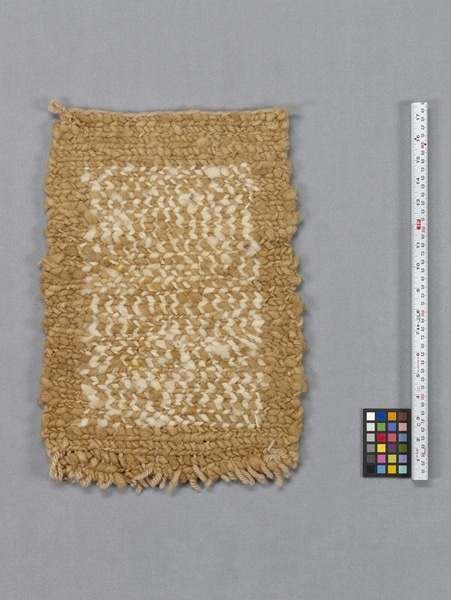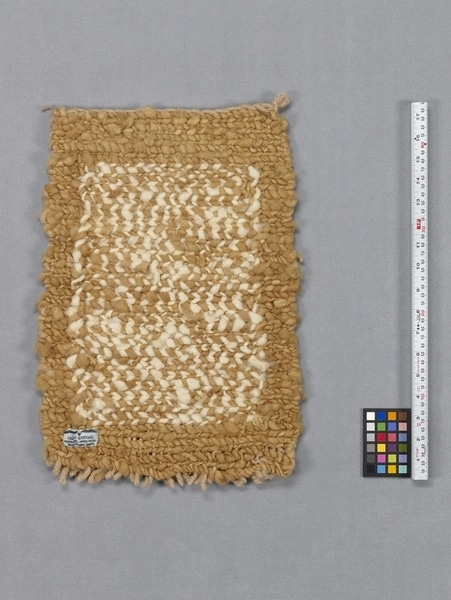Mat Item Number: 1615/1 from the MOA: University of British Columbia


Description
Rectangular wall hanging coarsely woven with light yellow-brown wool around the border and light yellow-brown mixed with off-white fibre at the centre. There are tassels of a different wool woven into the bottom row. The same wool is woven across the top. Blue 'Salish Weaving' tag sewn to back.
History Of Use
The Salish Weavers Guild was inspired by the research of amateur anthropologist, Oliver Wells. Mr. Wells, a local farmer, spent much of his time interviewing his Sto:lo neighbours about their history and cultural traditions, while making collections of cultural objects - many of which are now in the Chilliwack Museum. During the 1960s, Wells became especially interested in Salish loom weaving, and with the assistance of Mary Peters of Seabird Island, helped to organise a local guild that operated out of the Coqualeetza Cultural Center between 1971-1985. Weavers worked together to dye and spin wool. They made weavings on commission, or brought their work in to fill orders as they were recieved.
Cultural Context
weaving; contemporary
Narrative
Sto:lo weavers suggest this textile was made from sheep's wool that was not washed first, as the wool still feels oily. This would date back to the early years of the Salish Weavers Guild when everything was done by hand. This type of wool is still used, but the Salish Weavers Guild no longer exists. The artist attribution is based on another small weaving that is nearly identical to this one, with a tag identifying it to be the work of Josephine Kelly (in the collection of the Coqueleetza Cultural Society).
Item History
- Made by Josephine Kelly ? (Maker) in British Columbia, Canada between 1971 and 1982
- Collected in Chilliwack, British Columbia, Canada
- Owned before July 14, 1994
- Received from Unknown (Donor) on July 14, 1994
What
- Name
- Mat
- Identification Number
- 1615/1
- Type of Item
- mat
- Material
- wool fibre and onion skin dye ?
- Overall
- height 44.0 cm, width 28.5 cm
Who
- Culture
- Coast Salish: Sto:lo
- Creator
- Josephine Kelly ? (Maker)
- Previous Owner
- “Unknown” ?
- Received from
- Unknown (Donor)
Where
- Holding Institution
- MOA: University of British Columbia
- Made in
- British Columbia, Canada
- Collected in
- Chilliwack, British Columbia, Canada
When
- Creation Date
- between 1971 and 1982
- Ownership Date
- before July 14, 1994
- Acquisition Date
- on July 14, 1994
Other
- Item Classes
- textiles
- Condition
- good
- Current Location
- Case 6
- Accession Number
- 1615/0001